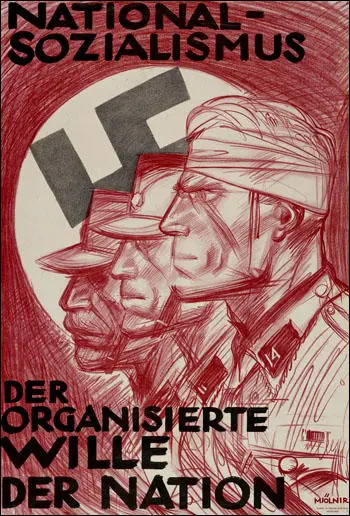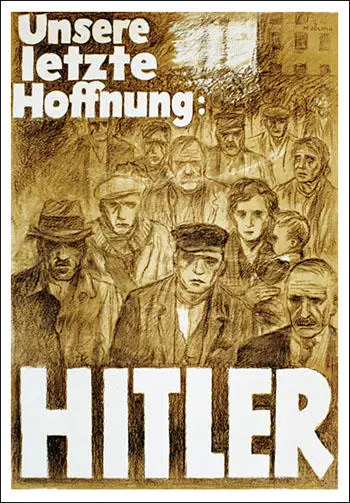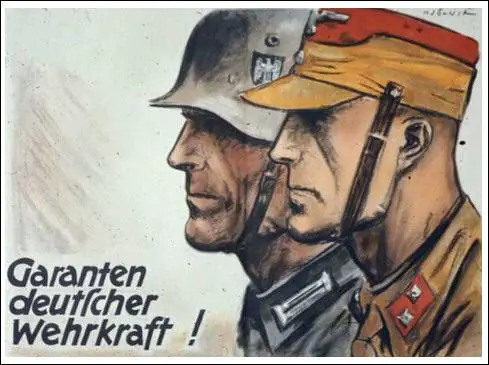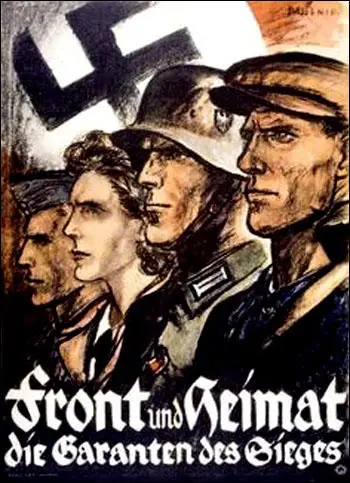Hans Schweitzer

Hans Schweitzer, the son of a navy officer, was born in Berlin on 25th July, 1901. As a young man he developed right-wing nationalist views and during the German Revolution took part in the fighting against the Spartacus League. (1)
A "rabid anti-Semite" he joined the Nazi Party in February 1926. (2) He soon began contribute illustrations to Völkischer Beobachter. He used the pseudonym of Mjölnir (name of Thor’s hammer in the old Germanic religion) and became a close friend of Joseph Goebbels. (3)
Schweitzer and Goebbels became followers of Gregor Strasser, who had joined forces with his brother, Otto Strasser, to establish the Berliner Arbeiter Zeitung, a left-wing newspaper, that advocated world revolution. Schweitzer began providing drawings for the newspaper. (4) in a diary entry Goebbels described Schweitzer as an "artistic genius". (5)
Goebbels also established the weekly Der Angriff (The Attack) in July 1927. Schweitzer was placed in charge of the poster campaign promoting the newspaper. According to Ralf Georg Reuth, the author of Joseph Goebbels (1993): "One trademark of Der Angriff was the caricatures by Hans Schweitzer... He knew how to translate his boss's verbal aggression into visual form... Goebbels's editorials and 'Political Diary,' combined with Schweitzer's caricatures, created a form of 'integrated political agitation' that in his eyes set Der Angriff apart from all the other papers in Berlin. Goebbels considered its propaganda effect 'irresistible,' with word and image serving 'not to convey information but to spur, incite, drive' the reader to action." (6)
Adolf Hitler became aware of Schweitzer's abilities and he designed several posters for his 1932 presidential campaign. This included his National-Sozialismus and Our Last Hope - Hitler. (7) Anthony Rhodes has argued that "his poster of the three Storm Troopers' heads is quintessential Nazi propaganda - simple, emotional, powerful." It reflected Hitler's idea that "by the masses, brutality and physical force are admired". Goebbels once said, "What lengthy speeches failed to do, Mjölnir did in a second through the glowing fanaticism of his powerful art." (8)
As Goebbels's protégé, Schweitzer was made Reich supervisor of artistic production in October 1935 and then promoted to Reich cultural senator, president of the Reich Chamber of the Fine Arts, and SS Sturmbannführer "on the staff of the Reichführer." His main task was to produce Nazi propaganda posters. It has been claimed that Schweitzer "knew how to translate his boss's verbal aggression into visual form." (9)
In June 1936, Joseph Goebbels wrote in his diary: "Horrible examples of art Bolshevism have been brought to my attention... I want to arrange an exhibit in Berlin of art from the period of degeneracy. So that people can see and learn to recognize it." (10) By the end of the month he had obtained Hitler's permission to requisition "German degenerate art since 1910" from public collections for the show. Goebbels actually liked modern art and was a collector of the work of Emil Nolde. As Richard J. Evans has pointed out: "Its political opportunism was cynical even by Goebbels's standards. He knew that Hitler's hatred of artistic modernism was unquestionable, and so he decided to gain favour by pandering to it, even though he did not share it himself." (11)
On 27th November, 1936, Goebbels issued the following decree: "On the express authority of the Führer, I hereby empower the President of the Reich Chamber of Visual Arts, Professor Ziegler of Munich, to select and secure for an exhibition works of German degenerate art since 1910, both painting and sculpture, which are now in collections owned by the German Reich, by provinces, and by municipalities. You are requested to give Professor Ziegler your full support during his examination and selection of these works." (12)
Adolf Ziegler and his entourage, including Hans Schweitzer, toured German galleries and museums and picked out works to be taken to the new exhibition, some museum directors were furious, refused to co-operate, and pleaded with Hitler to obtain compensation if the the confiscated works were sold abroad. Such resistance was not tolerated and some of them lost their jobs. Over a 100 works were seized from the Munich collections, and comparable numbers from museums elsewhere. (13)
It was decided to hold a Great German Art Exhibition in Munich. Adolf Ziegler, signed the announcement for the competition. "All German artists in the Reich and abroad" were invited to participate. The only requirement for entering the competition was German nationality or "race". After extending the deadline for submissions, 15,000 works of art were sent in, and of these about 900 were exhibited. According to official records, the exhibition had 600,000 visitors. (14) Hubert Wilm, a pro-Nazi artist, explained what they were trying to achieve: “Representation of the perfect beauty of a race steeled in battle and sport, inspired not by antiquity or classicism but by the pulsing life of our present-day events”. (15)
Several works produced by Schweitzer appeared in the First Exhibition of German Art, Munich was covered with Nazi flags. "In the streets perspiring Teuton warriors manhandled a giant sun and carried the tinfoil-covered cosmic ash-tree Yggdrasil (of German legend), in solemn procession... Regaled with these evocations of the past, the crowds entered the exhibition hall and found themselves - back in the past... Every single painting on display projected either soulful elevation or challenging heroism. Cast-iron dignity alternated with idyllic pastoralism. The many rustic family scenes invariably showed entire kinship groups... All the work exhibited transmitted the impression of an intact life from which the stresses and problems of modern existence were entirely absent - and there was one glaringly obvious omission: not a single canvas depicted urban and industrial life." (16)
in 1937 Schweitzer was named Reich Commissioner for Artistic Design and chairman of the Reich Committee of Press Illustrators. He continued to be active during the Second World War but according to Zbynek Zeman, the author of Selling the War: Art and Propaganda in World War II (1987), his recruitment and nationalist posters were not as effective as the ones he had produced in the 1930s. (17)
After the war, Schweitzer was initially arrested for his Nazi activities but he and his wife and children escaped to Schleswig-Holstein, and he was not captured until May 1947. He claimed that he was turned in by a modernist artist whom he had earlier attacked. Schweitzer had his Nazi record completely expunged in 1955. He changed his name to Herbert Sickinger and taught painting in Westphalia. Jonathan Petropoulos, the author of The Faustian Bargain: The Art World in Nazi Germany (2000) has pointed out "until his death... the important role he had played in the cultural life of the Third Reich, however, was not completely forgotten. The radical right-wing press in Germany, for example, noted his passing in glowing obituaries." (18)
Hans Schweitzer died on 15 September 1980.





Primary Sources
(1) Gerald Cinamon, Hans Schweitzer (2013)
Born 25 July 1901 in Berlin. Politically active from his late teens. Joins the Potsdam section of the NSDAP on 2 February 1926…and begins to contribute to the party press under the pseudonym of Mjölnir (name of Thor’s hammer in the old Germanic religion). Quickly becomes known for the quality and the vigour of his stroke, and his posters, caricatures, and drawings make him the most famous propagandist of the NSDAP. (The Völkischer Beobachter describes him in 1934 as "the sketcher par excellence of national-socialism"). By 1928 he was a friend of Joseph Goebbels and later illustrated a number of his books, including Die verfluchten Hakenkreuzler (Munich, 1930). October 1935: appointed by Hitler as Representative for Artistic Design.... a post which gives him authority (in conjunction with the Ministry of Propaganda in all areas of artistic activity directly dependent on the party: exhibitions... erection of monuments, development of insignia and national symbols (decorations, emblems, flags, uniforms, banknotes, stamps, diplomas, official seals, etc.). 1936: becomes honorary member of the SS with rank of Oberführer. Becomes a member of the advisory board of the Chamber of Art. In 1937, is a member of the organization committee of the exhibition in Munich on "degenerate art" and belongs to the commission assigned from 1938 on to decide how to utilize works removed on this occasion from the galleries and museums. 1943-4: artist with the Wehrmacht; his work published in the Völkischer Beobachter and Das Reich. 1945: in the German territorial army , captured by the Americans in Schleswig-Holstein; interned at Neuengamme. At war’s end, he and his wife and children escaped to Schleswig-Holstein, and he was not arrested until May 1947. He claimed that he was turned in by a modernist artist whom he had earlier attacked .
Hans Schweitzer had his Nazi record completely expunged in 1955. He proceeded to rehabilitate his career in the postwar period, during which he continued to find work as an illustrator. Schweitzer nevertheless decided to assume a new name…Under the name “Herbert Sickinger”, he taught painting in Westphalia to generations of German and American students... He prospered until his death in 1980. The important role he had played in the cultural life of the Third Reich, however, was not completely forgotten. The radical right-wing press in Germany, for example, noted his passing in glowing obituaries. In the 1950s and 1960s Schweitzer had continued to draw posters and illustrated for newspaper and journals such as Elsa, Mut and Deutsche Wochen-Zeitung. He died on 15 September 1980 in Landstuhl (Palatinate).
(2) Thule Art Gallery, Hans Schweitzer (June, 2020)
Hans Schweitzer's father was a medical officer in the Navy. During the revolutionary movements of 1918-1919 is fighting against militants Spartacist and performs its first themed designs anticommunist. In 1924 is the author of a DNVP party manifesto for the theme of the "stab in the back" (Dolchstoss, when you see a social democrat in disguise that affects a soldier's face treacherously) that makes him instantly famous.... Soon became famous for the quality and vigor of his drawings, poster, caricatures and paintings that make him the most famous propagandist of the NSDAP.... In addition to the work on Völkischer Beobachter he worked at weekly and fortnightly Berliner Arbeiterzeitung NS-Briefe published by the brothers Otto and Gregor Strasser which is closely related. Also becomes friend and one of the closest associates of Joseph Goebbels, with whom he spends the summer holidays in 1928 at Borkum.... During this period, he produced numerous paintings and posters...that enhance its reputation and help build the image of the militant National Socialist revolutionary and proletarian of the SA. He contributes regularly to the newspaper Der Angriff published by Goebbels.
(3) Anthony Rhodes, Propaganda: The Art of Persuasion: World War II (1987) page 24
The master of these political posters, on whom was bestowed the title of "Reich Plenipotentiary for Artistic Formulation" was the artist Mjölnir (Hans Schweitzer). As a Nazi leader once said, "What lengthy speeches failed to do, Mjölnir did in a second through the glowing fanaticism of his powerful art." Mjölnir's poster of the three Storm Troopers' heads is quintessential Nazi propaganda - simple, emotional, powerful. Hitler had said, "by the masses, brutality and physical force are admired." Here they are. These are three Nazi "fighters," one young, the second middle-aged, the third an older man, who have all clearly passed through the fires of combat, in the trenches or the streets, and whose faces have a male strength verging on brutality. Done in 1932, one poster depicts the "Aryan" fighting to bring the Nazi movement to power.
(4) Zbynek Zeman, Selling the War: Art and Propaganda in World War II (1987) page 37
Mjölnir - Hans Schweitzer was his proper name - embodied the spirit and the aspirations of the Nazis in his drawings more effectively than any other contemporary German artist. He specialized in images of iron-jawed storm-troopers; his famous 1932 election poster "National Socialism, the Organized Will of the Nation" had the profiles of three such storm-troopers superimposed on each other. In comparison his wartime recruitment poster for the SS, "You Can Join Them on Your 17th Birthday", lacked some of the brutality of his pre-war stylized thugs. The small patriotic motif in the background - the Nazi standard - was based on a design by Hitler himself.
(5) Ralf Georg Reuth, Joseph Goebbels (1993)
One trademark of Der Angriff was the caricatures by Hans Schweitzer. This Goebbels confidant, who also did drawings for the Völkischer Beobachter and the Brennessel, signed his work with the old Germanic name for the Thor's hammer, Mjölnir. As Goebbels's protégé, Schweitzer would be made Reich supervisor of artistic production in October 1935 and then advance to Reich cultural senator, president of the Reich Chamber of the Fine Arts, and SS Sturmbannführer "on the staff of the Reichführer." He knew how to translate his boss's verbal aggression into visual form. Even before he founded Der Angriff, Goebbels had greatly admired Schweitzer's "artistic genius". Goebbels's editorials and "Political Diary," combined with Schweitzer's caricatures, created a form of "integrated political agitation" that in his eyes set Der Angriff apart from all the other papers in Berlin. Goebbels considered its propaganda effect "irresistible," with word and image serving "not to convey information but to spur, incite, drive" the reader to action.lnir - the name of Thor’s hammer - or his name given to him by Goebbels for his kinetic illustrative style.
References
(1) Thule Art Gallery, Hans Schweitzer (June, 2020)
(2) Ralf Georg Reuth, Joseph Goebbels (1993) page 89
(3) Gerald Cinamon, Hans Schweitzer (2013)
(4) Toby Thacker, Joseph Goebbels: Life and Death (2009) page 87
(5) Joseph Goebbels, diary entry (15th September 1929)
(6) Ralf Georg Reuth, Joseph Goebbels (1993) page 91
(7) Zbynek Zeman, Selling the War: Art and Propaganda in World War II (1987) page 37
(8) Anthony Rhodes, Propaganda: The Art of Persuasion: World War II (1987) page 24
(9) Ralf Georg Reuth, Joseph Goebbels (1993) page 89
(10) Joseph Goebbels, diary entry (June, 1936)
(11) Richard J. Evans, The Third Reich in Power (2005) page 171
(12) Frederic Spotts, Hitler and the Power of Aesthetics (2002) pages 151–168
(13) Richard J. Evans, The Third Reich in Power (2005) page 171
(14) Berthold Hinz, Art in the Third Reich (1979) pages 8-9
(15) Peter Adam, Art of the Third Reich (1992) page 179
(16) Richard Grunberger, A Social History of the Third Reich (1971) page 537
(17) Zbynek Zeman, Selling the War: Art and Propaganda in World War II (1987) page 37
(18) Jonathan Petropoulos, The Faustian Bargain: The Art World in Nazi Germany (2000) pages 162-163
